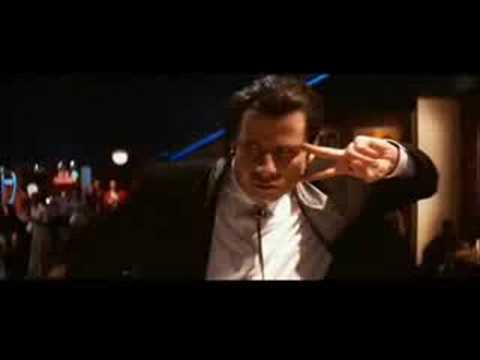***CONTAINS SPOILERS***
What I love about Quentin Tarantino more so than his style and his panache for good, quotable, punchy dialogue, is the fact that each time I watch one of his movies, they seem to just get better. I re-watched Pulp Fiction yesterday and realised that it isn’t just a good movie, it’s a great movie, this is mainly because it’s very layered. It’s layered in the sense that in each individual scene there’s so much to like, and the genius of it is, is the fact that none of the direction or the writing ever seems forced, but quite natural. Pulp Fiction is a crime film with an almost charmingly elegant flow to it.
It’s often been commented on how Pulp Fiction is (sorry for the cliché) ‘laugh-out-loud hilarious’. Indeed, there has been a lot said about how this is partially to do with the absurd/sly/darkly-comic nature of the film, and more importantly, it’s very quotable dialogue (“I’ma get medieval on ya ass”; “Oh man, I just shot Marvin in the face”). Yet, I think it’s more than that. There’s something about the way Tarantino has written Pulp Fiction that induces a laugh in a line, even though this line never even ‘asks’ for a laugh. Take the section in the beginning where Jules and Vincent are discussing all manner of irrelevant subjects on their way to the next job: drug laws in Amsterdam, names of burgers in Paris, television pilots. The back-and-forth feel to the dialogue and it’s fast-paced snappiness creates an element of humour in some of the dialogue, even though there are no puns. It’s like having banter with a best mate and occasionally smiling or laughing half-way through a sentence, you’re having such a good time that you’re giggling for no apparent reason. Of course, Pulp Fiction does provide puns: later on, Jules and Vincent discuss the monumental difference between eating our a girl’s “holiest of holies” or giving her a foot massage.
Indeed, what further adds to the joy of the film is the fact that Tarantino knows that the essentially aimless dialogue puts it above other films. So much so that he uses dialogue to manipulate the audience in very unexpected ways. Jules and Vincent have just arrived at the flat, they’re about to open the door, yet stop and suddenly move up the corridor to discuss the ethics of massaging the feet of a married woman. To add to this further is the fact that the camera simply pans around and then lingers in the same spot near the door. All of this builds up a sense of comedy, and more importantly: intrigue, about what’s behind the door.
Such directorial techniques are one of the many aspects which make the film effortlessly drip moments of greatness throughout. This is one of the many aspects of the film which is often overlooked, as the script is often the main thing that gleams into our eyes when we are first fused and engaged with Tarantino’s film. This directorial style is usual down to the camera work in the film; yet, even though each individual shot doesn’t strike us immediately like an image from a Kubrick or a Lynch or a Nolan film – each shot still maintains some form of intensity. This intensity is created by the clear precision it is created in, Tarantino takes his time with each shot, he doesn’t edit them away like Michael Bay does, one single shot may last from thirty seconds to two minutes. The dance sequence between Mia and Vince is a good example of this, as the dance itself lasts for a seemingly long period of time, and each shot lingers on them, however, it never becomes boring, because…well…it’s a strange dance, yet it oozes cool and style.
Pulp Fiction has often been criticised for being very violent. Yet, it’s not as violent as everyone makes it out to be. To give a completely blunt and famous example, it works in the same way that Alfred Hitchcock’s Psycho works in: we never see the knife go in, or in the case of Pulp Fiction, we never see the samurai sword stabbed into the toe of a pervert. Tarantino is very good at directing violence. We see violence so much in the movies that it rarely affects us; fight scenes make us doze off to sleep or just want them to immediately end. Tarantino keeps us on our toes. He directs violence in such an energetic style that it actually does something: it shocks, surprises, evokes comedy, and occasionally makes us cringe.
An example of this, is when Mia is injected in the heart due to a drug-overdose, although perhaps not violence, it works by the same method as a knife going into Janet Leigh’s stomach does: we don’t see it. It’s all implied. There’s a chilling low-angle close-up of the needle which lasts for a few seconds and the counting from 1 to 3 seems to last forever, until we eventually see the needle go in and wince as doing so, there’s a build-up to the moment of injection before we here the bumff of the needle shred through the skin and sink in. “Trippy”, eh?
Howard Hawks once said that a great movie involves: “Three good scenes. No bad scenes.” Pulp Fiction goes a step further: all good scenes, not one bad scene at all.





hello.i love movie.good blog. i am fan john
thanks! good that you like the blog…have you subscribed? 😀
Pingback: Top 250 movies « Jaggi
Pingback: MusicLog #5 : Pulp Fiction… « For Whatever It's Worth…
Pingback: Top 10 Movie Actors (female) « Radu presents: The Movie-Photo Blog